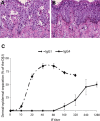IgG4 autoantibodies induce dermal-epidermal separation
- PMID: 17979887
- PMCID: PMC4401274
- DOI: 10.1111/j.1582-4934.2007.00081.x
IgG4 autoantibodies induce dermal-epidermal separation
Abstract
Bullous pemphigoid (BP) is a sub-epidermal autoimmune blistering disease associated with autoantibodies to the dermal-epidermal junction (DEJ). Patients' autoantibodies induce dermal-epidermal separation when co-incubated with cryosections of human skin and leucocytes from healthy volunteers. IgG autoantibodies trigger complement and/or leucocyte activation resulting in specific pathology in several autoimmune conditions. In these diseases, IgG1 and IgG3 isotypes, but not the IgG4 subclass, are thought to trigger inflammatory pathways resulting in tissue damage. The capacity of IgG4 autoantibodies to mediate tissue damage has not yet been demonstrated. In this study, we isolated IgG1 and IgG4 autoantibodies from bullous pemhigoid patients'serum and analysed their blister-inducing potential in our cryosection assay. As expected, complement-fixing IgG1 autoantibodies induced sub-epidermal splits in this experimental model. Purified IgG4 did not fix complement, but, interestingly, like IgG1, activated leucocytes and induced dermal-epidermal separation. The potential of IgG4 autoantibodies to induce Fc-dependent dermal-epidermal separation was significantly lower compared to IgG1. Our results demonstrate that IgG4 autoantibodies are able to activate leucocytes and point to a hitherto less recognized function of IgG4. Moreover, for the first time, we clearly demonstrate that BP IgG4 autoantibodies have the capacity to induce leucocyte-dependent tissue damage.
Figures






Similar articles
-
Autoantibodies to bullous pemphigoid antigen 180 induce dermal-epidermal separation in cryosections of human skin.J Invest Dermatol. 2002 Apr;118(4):664-71. doi: 10.1046/j.1523-1747.2002.01720.x. J Invest Dermatol. 2002. PMID: 11918714
-
Granulocyte-derived elastase and gelatinase B are required for dermal-epidermal separation induced by autoantibodies from patients with epidermolysis bullosa acquisita and bullous pemphigoid.J Pathol. 2004 Dec;204(5):519-27. doi: 10.1002/path.1674. J Pathol. 2004. PMID: 15538734
-
Pathogenicity of autoantibodies in anti-p200 pemphigoid.PLoS One. 2012;7(7):e41769. doi: 10.1371/journal.pone.0041769. Epub 2012 Jul 24. PLoS One. 2012. PMID: 22911854 Free PMC article.
-
IgG4, complement, and the mechanisms of blister formation in pemphigus and bullous pemphigoid.J Dermatol Sci. 2017 Dec;88(3):265-270. doi: 10.1016/j.jdermsci.2017.07.012. Epub 2017 Jul 18. J Dermatol Sci. 2017. PMID: 28747266 Review.
-
Bullous pemphigoid: role of complement and mechanisms for blister formation within the lamina lucida.Exp Dermatol. 2013 Jun;22(6):381-5. doi: 10.1111/exd.12146. Epub 2013 May 7. Exp Dermatol. 2013. PMID: 23651418 Review.
Cited by
-
Conceptualization and validation of an innovative direct immunofluorescence technique utilizing fluorescein conjugate against IgG + IgG4 for routinely diagnosing autoimmune bullous dermatoses.Cent Eur J Immunol. 2021;46(2):183-190. doi: 10.5114/ceji.2021.107028. Epub 2021 Jun 15. Cent Eur J Immunol. 2021. PMID: 34764786 Free PMC article.
-
IgG4-associated cholangitis: a comprehensive review.Clin Rev Allergy Immunol. 2015 Jun;48(2-3):198-206. doi: 10.1007/s12016-014-8430-2. Clin Rev Allergy Immunol. 2015. PMID: 24958363 Review.
-
Prevalence of collagen VII-specific autoantibodies in patients with autoimmune and inflammatory diseases.BMC Immunol. 2012 Apr 4;13:16. doi: 10.1186/1471-2172-13-16. BMC Immunol. 2012. PMID: 22471736 Free PMC article.
-
IgG4-related Inflammatory Abdominal Aortic Aneurysm, Spectrum of IgG4-related Chronic Periaortitis.Ann Vasc Dis. 2010;3(3):182-9. doi: 10.3400/avd.sasvp01002. Epub 2010 Dec 2. Ann Vasc Dis. 2010. PMID: 23555408 Free PMC article. No abstract available.
-
Advancing Treatment in Bullous Pemphigoid: A Comprehensive Review of Novel Therapeutic Targets and Approaches.Clin Rev Allergy Immunol. 2023 Dec;65(3):331-353. doi: 10.1007/s12016-023-08973-1. Epub 2023 Oct 28. Clin Rev Allergy Immunol. 2023. PMID: 37897588 Review.
References
-
- Liu Z. Immunopathology of bullous pemphigoid, an autoimmune and inflammatory skin blistering disease. Keio J Med. 2003;52:128–33. - PubMed
-
- Sitaru C, Zillikens D. Mechanisms of blister induction by autoantibodies. Exp Dermatol. 2005;14:861–75. - PubMed
-
- Sitaru C, Schmidt E, Petermann S, Munteanu SL, Bröcker EB, Zillikens D. Autoantibodies to bullous pemphigoid antigen 180 induce dermal-epidermal separation in cryosections of human skin. J Invest Dermatol. 2002;118:664–71. - PubMed
-
- Yamamoto K, Inoue N, Masuda R, Fujimori A, Saito T, Imajoh-Ohmi S, Shinkai H, Sakiyama H. Cloning of hamster type XVII collagen cDNA, and pathogenesis of anti-type XVII collagen antibody and complement in hamster bullous pemphigoid. J Invest Dermatol. 2002;118:485–92. - PubMed
Publication types
MeSH terms
Substances
LinkOut - more resources
Full Text Sources
Medical
Research Materials

